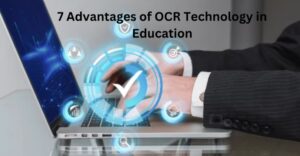7 Advantages of OCR Technology in Education
Ever wonder how OCR technology could transform teaching and learning? How can turning pictures into text give teachers and students access to a whole new range of opportunities?
Every query will be answered in this article. With a wealth of information, it is a practical form of technology that can solve issues, boost productivity, cut costs, and lower carbon emissions.
There are several OCR tools that serve as the building blocks of modern classrooms. The utilization of sophisticated optics in character recognition can create a supportive atmosphere for differently-abled learners.

What is OCR Technology?
Optical Character Recognition (OCR) is the method that changes an image of content into a machine-readable text format. OCR technology is commonly used to recognize text in scanned documents and images. OCR software converts physical documents or images into accessible electronic versions with text.
This helps in the extraction of text from every type of image. It could be used on an image from any page in a book or any colored Google image for information. Some of these benefits are highlighted in the following points.
Benefits of OCR for students:
Let us take a look at some benefits of OCR in education and academics as listed below.
Makes work easier for teachers
There is a lot of work involved when managing a classroom. The preparation of lesson plans, designing instruction materials, and grading are some of the tasks to be done. However, OCR helps teachers produce educational materials quicker and smarter.
This technology makes it possible to make a digitized version from a single printable copy of a chapter or an article and distribute it among learners within seconds. Say goodbye to retyping materials as teachers now only have to scan, convert, and print their needs. It then becomes easier to devote the remaining effort and time towards enhancing student-teacher relationships.
Assist Visually Impaired Students
Similarly, digital texts are said to be flexible; they do not limit themselves to any particular font, color, or size like the usual print materials. In a way, one of the best areas that makes it worth the OCR solution is dealing with blind students.
Converting print text into digital text allows teachers to design texts having bigger fonts and nice colors to ensure legibility for those requiring it.
Simplifies the Data:
OCR tools greatly reduce the data to a simple form. Such data imprinted in images can only show unclear and blurred images while using a mouse and keyboard only can get the information converted into a simple text form.
These JPG to word tools make reading and understanding written information that may not seem easy such as those written on the sides, written in captcha codes for registering into any website or portal sign-in easily and effectively. These applications help in reading texts in images that are difficult or impossible to read due to low resolution, which is why they are considered helpful. Hence, OCR tools simplify studies for students.
Revolutionize the process of notetaking
The creation of the MNIST Database has made it possible for the OCR technology to discern and recognize text that is handwritten. This database consists of some 600,000 images of hand-written letters and figures that were taken from United States Census archival records.
Optical character recognition, the capability to read the hand-written text and convert it into a digital input, is exactly what makes it such a force where offices that operate mostly based on paper but need to use computers simultaneously. It readily applies in schools whereby students convert their handwritten notes into searchable, digital documents for study purposes.
Save Time:
It would take much time to read the indiscernible text and data; however, one can spare precious moments and fuel with these tools.
For projects like research thesis projects, that require tremendous data, students waste a lot of time in looking through several PDF files and articles; they hardly get any that allow them to download or even open but these tools save their time and energy.
It is straightforward to copy any text out of one’s scanned PDF file, hence getting its text readily for your use in your content. These text extractor tools can also be used to convert blurred screenshot images into text on occasion.
Improved Usability and Create interactive materials:
The usage of OCR technology makes the game available for students, those who don’t have time to play. Transform images into texts by applying OCR so that visually impaired students can access their learning tools conveniently. Students can download OCR/ voice recognition applications on their mobile phones and tablets thus reading out print for them so that they can interact with content in a new way.
The use of OCR technology can open endless opportunities for developing interactive educational products that transform pictures into text. instructors can convert readings, worksheets, etc., into an easy-to-use organizer.
This provides a way of combining different forms of multimedia such as video clips, audio clips, and real-time interactive questions, to enable learners to engage in an interactive process that makes sense and captures their attention.
The use of OCR technology in making flexible learning programs that provide content tailored to the specific needs of students would allow students to learn to engage extensively.
Help Students Overcome Reading Challenge
The International Dyslexia Association states that about 6-7% of school-going children suffer learning disability (LD) specifically in writing and or reading (85%). Many of those students find it incredibly difficult to deal with the text-based curriculum.
These students can only read while OCR is a ray of hope for such students, where they can listen to a lecture, do homework, and notes as opposed to reading. Further, it creates accessible digital paperwork, in which students can look up the definition of virtually any word or bookmark particular parts of the content. A potential solution is optical character recognition, which allows students to read everything.
The future of OCR in Education:
It is also crucial to know the limitations faced by OCR technology. Sometimes OCR accuracy depends on the clarity of the document, as it were, or the quality of scanning. Minimizing change also necessitates trust in the truth. human written
Some schools may not have sufficiently tight resources for the purchase of OCR software and equipment. However, with advancements in technology, OCR systems should become more accurate, affordable, and easy to use, enabling access to even greater learning.
Conclusion
With this in mind, one of the most promising OCR technologies is its power to boost education by turning pictures into searchable and adjustable information. The impact of OCR on teaching and learning makes it easier for researchers to conduct research that is of high quality, improves the general healthcare practice, and facilitates the production of interactive data.
With time, education keeps on changing, and therefore its educators need to utilize the application of OCR in education as a gadget that can promote student participation while revealing the transformative energy of learning.
Author Profile

-
Hi I am Karan a passionate blogger. It's almost 4.5 years when I started blog writing in 2019. I am the owner of the Readree.com. My dedication to delivering reliable information and useful tips has earned him a loyal following among tech enthusiasts seeking reliable insights and recommendations.
If You have any query then email Us. sabinbaniya2002@gmail.com
Latest entries
 CouponJanuary 14, 2025Myntra Referral Code Get Rs 1300 Off On Your Order
CouponJanuary 14, 2025Myntra Referral Code Get Rs 1300 Off On Your Order  AlternativeJanuary 11, 2025Top 10 Best Stream2Watch Alternatives in 2025 (Stream Free)
AlternativeJanuary 11, 2025Top 10 Best Stream2Watch Alternatives in 2025 (Stream Free) CouponJanuary 10, 2025Probo Referral Code today – ‘5t6izt’ Earn Up To Rs 50
CouponJanuary 10, 2025Probo Referral Code today – ‘5t6izt’ Earn Up To Rs 50 GAMESJanuary 9, 2025Top 10 Most Expensive Tennis Rackets in the World
GAMESJanuary 9, 2025Top 10 Most Expensive Tennis Rackets in the World